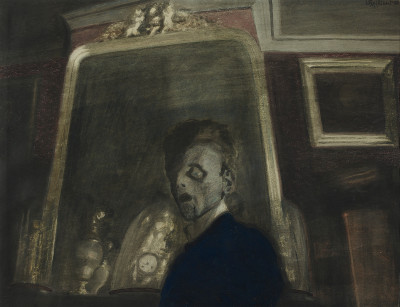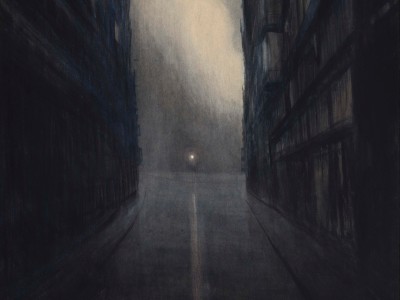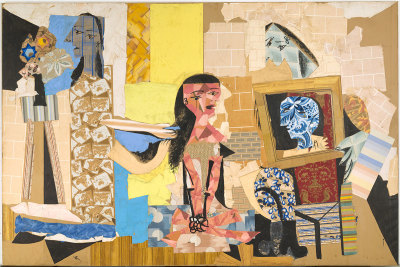In the early hours with Léon Spilliaert
In the early hours with Léon Spilliaert
By Alan Hollinghurst
Published 8 January 2020
Léon Spilliaert’s strange nocturnal atmospheres are pregnant with mystery and silence. Novelist Alan Hollinghurst explores the Belgian artist’s shadowy interiors, shelterless landscapes and probing self-portraits.
-
From the Winter 2019 issue of RA Magazine, issued quarterly to Friends of the RA.
Alan Hollinghurst is a novelist. His books include The Folding Star, which is set in Belgium, and The Line of Beauty, for which he won the Man Booker Prize.
-

Léon Spilliaert, Self-portrait, 3 November, 1908.
Indian ink wash, brush, coloured pencil, pastel and Conté crayon on paper. 49.7 x 65.1 cm. Private collection.
-
A long sequence of self-portraits, executed through his twenties, shows the Belgian painter Léon Spilliaert either from the left or, less often, head on. His head itself is remarkable, described by a contemporary as “bony, pronounced, with deeply sunken cheeks”, with an “astonishing blond shock of hair, tousled, almost fantastic”, and (what seems to have struck everyone) staring eyes, “soft and dreamy” but with a “gloss of cold steel”.
Many of the self-portraits are night pictures: Spilliaert was an insomniac and a solitary explorer of nocturnal states of mind. The sequence evolves from simple depictions of head and shoulders to highly complex examinations of his figure in interior space, a play of reflections in mirrors and dark windows with looming domestic details. The space itself takes on for the viewer the air of a conundrum, subtly enlarging the riddle of mortality: in Self-portrait, 3 November, 1908, the single digit on a tear-off calendar marks the passage of time, likening the picture to a journal entry or essay in lamp-lit self-examination, a reckoning with inexorable fate. If we are shown the blazing blue eyes we are also shown the skull beneath the skin.
-

Léon Spilliaert, Interior (Bedroom with Beam of Light), 1908.
Indian ink wash, brush and coloured pencil on paper. 63.4 × 48.4 cm. Musée d’Orsay. Photo: © Musée d'Orsay, Dist. RMN-Grand Palais / Patrice Schmidt.
-
In these earlier years there are broadly indoor pictures and outdoor pictures, shadowy interiors and shelterless visions of sea and shore. Spilliaert was often severely ill with stomach ulcers, and the indoor scenes, partial and mysterious, convey the invalid’s sense of the bedroom as both a refuge and a trap.
In Bedroom with Beam of Light (1908), the privacy of the bedroom is penetrated by the implacable brilliance of the Ostend lighthouse, picking out impartially the white coverlet, brass bed-knobs and white china casters of the bed, and drawing a half-disc of blue on the reflecting surface of a sombre armoire. It’s rare for Spilliaert to suggest an easy movement between indoor and outdoor worlds – in 1908 he rented a studio looking over the fishing port at Ostend, and the delicate Studio Window at Visserskaai (1908-09) is a reminiscence of Caspar David Friedrich’s drawings of the masts of ships seen through his studio’s open casement.
But once Spilliaert gets outside, he’s looking at the overwhelming blackness of the sea, or at vast structures like Ostend’s Royal Galleries, whose columns recede neverendingly along the unpeopled seafront (Promenade, Light Reflections, 1908). Ostend, where he was born in 1881, and where he spent much of his life, becomes the theatre of his imagination, less as fashionable resort than as a place where humanity confronts the elements. Long-suffering fishermen’s wives wait for the boats to return, and the admonitory beam of existential questions shines through the fabric of the everyday.
-

Léon Spilliaert, The Window of the Studio on the Visserskaai, 1908–09.
Indian ink wash, brush, coloured pencil and pastel on paper. 63.6 x 48.2 cm. Private collection.
-
Strikingly, Spilliaert shares almost nothing with the older and more famous Ostend artist, James Ensor. Other influences may sometimes be glimpsed in his work – from the airless refinement of the great Belgian Symbolist painter Fernand Khnopff, to Edvard Munch’s haloed figures, seen from behind, to the deserted colonnades and squares of Giorgio de Chirico’s metaphysical townscapes. But Spilliaert was by temperament a loner, not a joiner, and he could never be mistaken for any of these artists: he is always, insistently, himself. He made lithographs to illuminate Maurice Maeterlinck’s precociously surreal poem-sequence ‘Les Serres Chaudes’ in 1918; he also depicted himself and the publisher Edmond Deman, in a delicate etching from 1908, with Emile Verhaeren, the other leading Flemish poet of the previous generation. Yet unlike so much art of the turn of the century his was not at all literary: he found his own compelling subject in the mystery of existence and the astonishing presence of the physical world.
-

Léon Spilliaert, Beech Trunks, 1945.
Indian ink and watercolour and pencil on paper. 60 x 49 cm. Private Collection. Photo: © Cedric Verhelst.
-
Spilliaert’s large oeuvre is almost all on paper: watercolour, gouache, pencil, pastel, pen-and-ink, explored and combined with great virtuosity. The scale is correspondingly small, and there are areas of his work – the mesmerising studies in Indian ink of empty or half-full flasks (Bottles, 1909), the discreetly glowing pastels of cardboard boxes stacked against a mirror – that demand the intimate responsiveness that was the ideal of much northern Symbolist art: an act of silent, sustained attention to the mystery of things.
Other pictures are so startling in their imagery that they imprint themselves instantly on the retina of the mind: zooming beach-scapes, chasmal night streets, scenes reduced to their bare essence. Spilliaert can be humorous – though we might not always be sure if we’re meant to laugh. Sometimes his figures are seen with the cartoonist’s eye; his Ostend bathers and solitary walkers have a hint of caricature in their enigmatic makeup.
A subtle humour seems inherent even in the paintings of the airship Belgique II in its hangar – a subject in which Spilliaert, as a poet of the crepuscular sublime, finds an abstract monumentality offset by the ant-like minuteness of the attendant human figures. If the great period of his art was the early 20th century, he went on working inventively up to his death in 1946. Beech Trunks (1945), made in the last year of his life, seems cryptically of its time as well as indisputably his own: autumn leaves, low grey sky, something faced, and a rare graphic beauty discovered.
-
Léon Spilliaert is on at the Royal Academy of Arts, London from 23 February — 25 May 2020. Exhibition organised by the RA in collaboration with the Musée d’Orsay, Paris, and supported by the Government of Flanders.
-
-
Enjoyed this article?
Become a Friend to receive RA Magazine
As well as free entry to all of our exhibitions, Friends of the RA enjoy one of Britain’s most respected art magazines, delivered directly to your door. Why not join the club?

-








